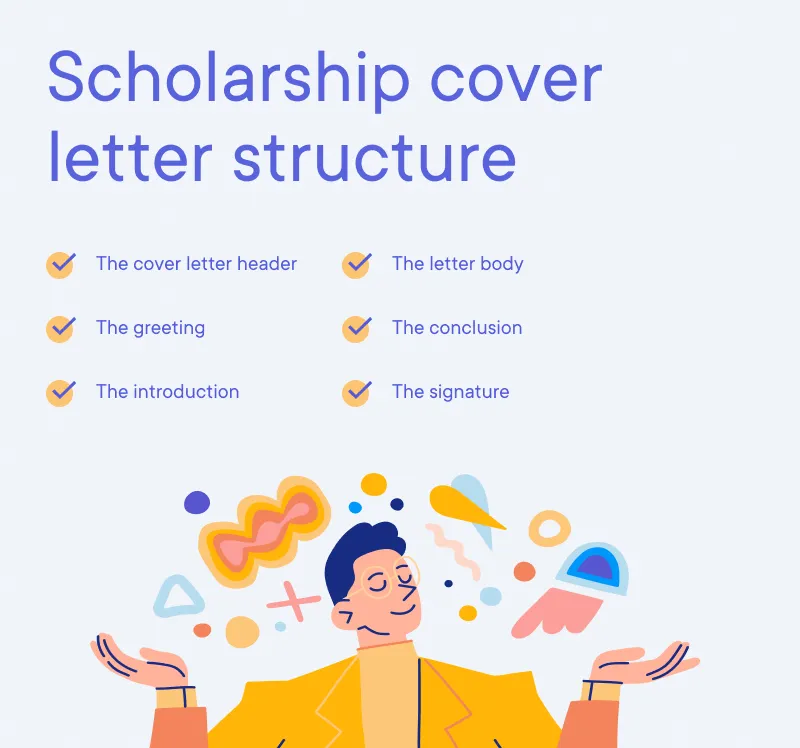What is a Scholarships Cover Letter
A scholarships cover letter is a crucial document that accompanies your scholarship application. It serves as your personal introduction, providing the scholarship committee with insights into your qualifications, aspirations, and why you deserve the financial assistance. Unlike a resume, which lists your accomplishments, a cover letter offers a narrative, allowing you to connect with the reviewers on a personal level. This is your chance to tell your story, highlighting your unique qualities and demonstrating how the scholarship will help you achieve your educational and career goals. The cover letter complements your application, making it stand out from the crowd and significantly increasing your chances of success. It is a vital element in your quest for funding.
Why a Scholarships Cover Letter Matters
A well-crafted scholarships cover letter can be the deciding factor in whether you receive a scholarship. It’s your opportunity to make a positive first impression and convince the selection committee that you are the right candidate. The cover letter lets you showcase your personality, values, and motivations beyond the basic information in your application. It provides context to your academic achievements and extracurricular activities, demonstrating how these experiences have shaped you and prepared you for higher education. A compelling cover letter can differentiate you from other applicants, especially when the competition is fierce. It demonstrates your ability to communicate effectively, a crucial skill for academic and professional success. A strong cover letter underscores your genuine need for financial assistance and your commitment to making the most of the scholarship opportunity, ultimately increasing your chances of being selected.
Key Components of a Scholarships Cover Letter
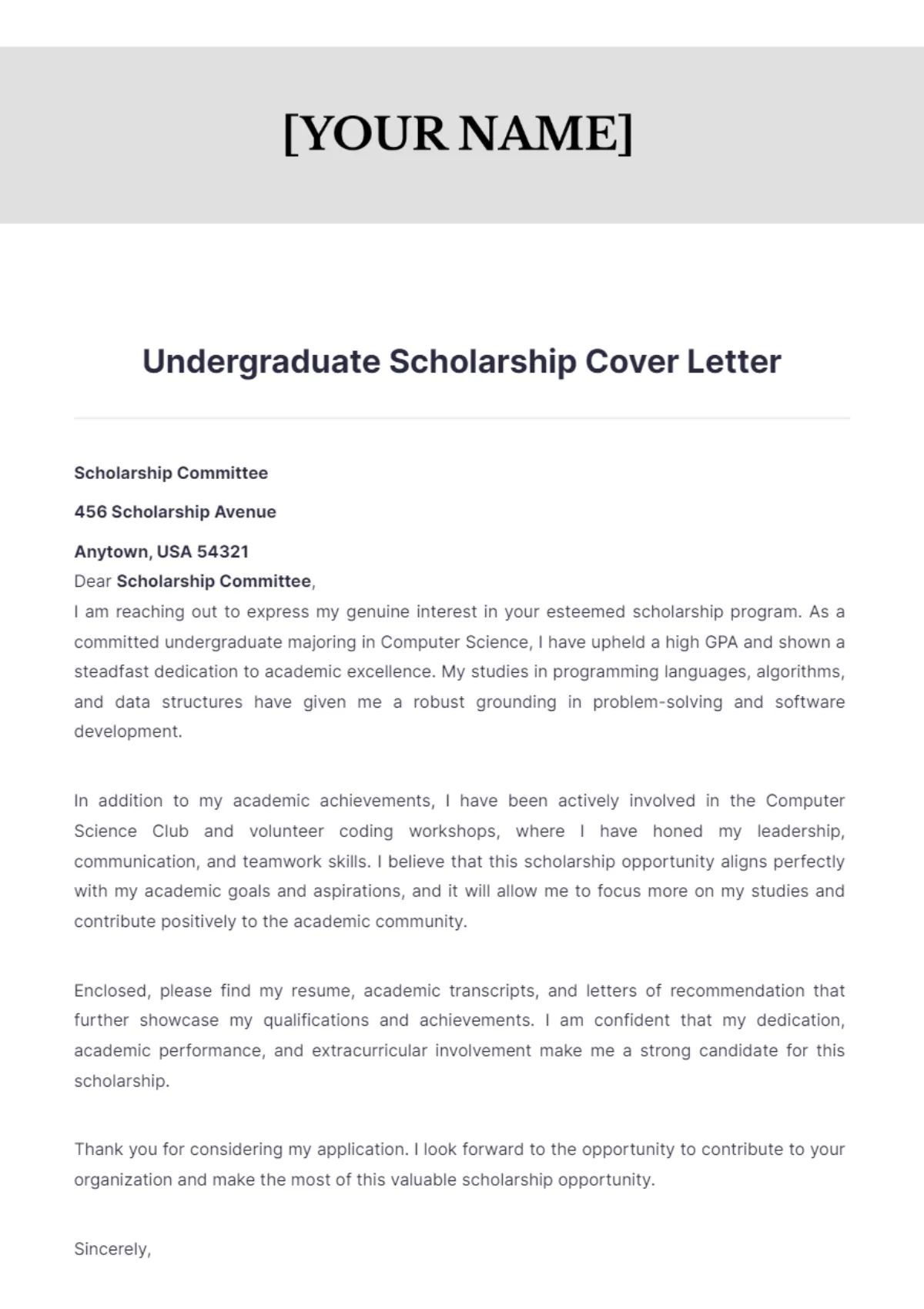
A successful scholarships cover letter consists of several key components working together to create a compelling case for your application. These elements include the header and contact information, the salutation, the body paragraphs, and the closing. Each section plays a specific role in conveying your message. The header sets the tone with your personal details and the scholarship provider’s information. The salutation ensures a professional and respectful start. The body paragraphs are the heart of your letter, where you describe your academic achievements, extracurricular activities, financial needs, and future goals. The closing paragraph expresses gratitude and reiterates your interest in the scholarship. Adhering to a structured format ensures clarity and professionalism, making your letter easy to read and understand. Carefully crafting each of these components is critical to demonstrating your suitability for the scholarship and maximizing your chances of being selected.
Header and Contact Information
The header of your scholarships cover letter is the first thing the selection committee sees, making a strong first impression critical. It should include your full name, address, phone number, and email address. This information allows the committee to easily contact you. Following your information, include the date and the scholarship provider’s details. This should include the name of the scholarship, the name of the organization, and the address. The header sets a tone of professionalism and attention to detail. Ensuring that the information is accurate and easy to read demonstrates your organizational skills and commitment to the application process. Proper formatting, such as using a clear font and sufficient spacing, contributes to a polished and professional presentation. Always double-check your contact information before submitting your cover letter to ensure accuracy.
Applicant’s Name and Contact Details
Start the header with your full name, and follow with your complete mailing address. Include your phone number, making sure it is one you regularly check, and provide a professional-looking email address. This will allow the scholarship committee to easily reach out to you. Using a professional format with clear and legible information helps to establish your credibility from the outset. Avoid using informal language or nicknames; present yourself in a formal and respectable manner. Keep all details updated and accurate. Proofread carefully to avoid any typos or errors, as this impacts your professionalism. Remember, this section gives the first impression, so accuracy and clarity are crucial for setting a positive tone for your application.
Scholarship Provider’s Information
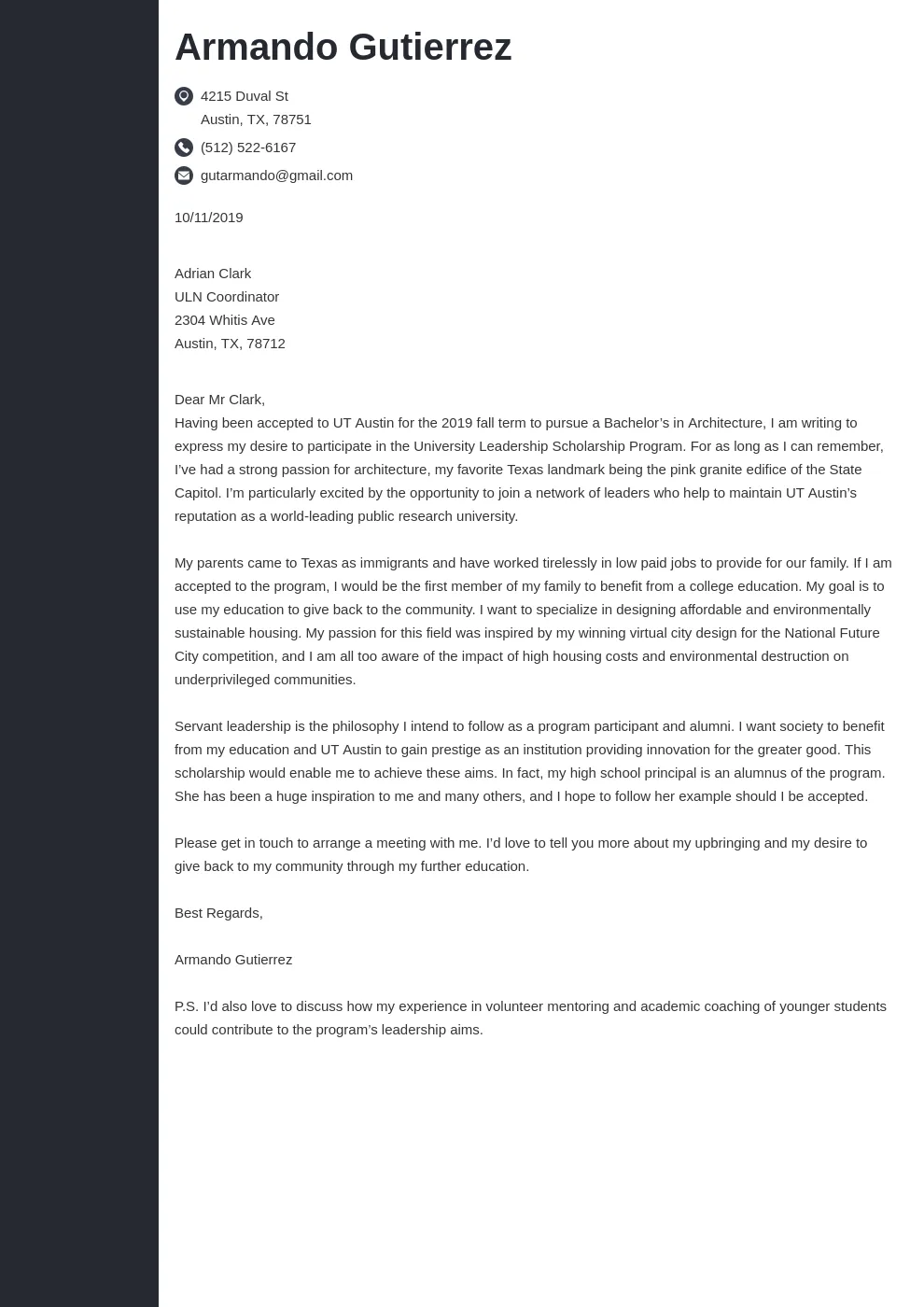
Below your contact information and the date, include the scholarship provider’s details. This typically starts with the name of the scholarship or the organization offering it. Following the name, include the full address of the scholarship provider. This is important for formal correspondence. This part of the header displays that you have targeted the right recipient for your application. It also indicates that you have taken the time to research and understand the details of the scholarship. Using the correct information adds to your credibility and demonstrates attention to detail. Accuracy in this area helps show your respect for the scholarship provider, enhancing the professional impression you make. Checking for correct spellings and verifying the address are essential steps before submitting your application.
Salutation: Addressing the Review Committee
The salutation is the formal greeting that opens your scholarships cover letter, setting the right tone for your application. Start by addressing the committee or the specific person in charge of reviewing the applications. The most common salutation is ‘Dear Scholarship Committee’ or ‘Dear [Name of the Scholarship Contact].’ If you can find out the name of the person in charge, address them directly; this shows that you’ve done your research and adds a personal touch. Use professional and polite language, and make sure to spell their name correctly. If you are unsure of the contact person’s name, using ‘Dear Scholarship Committee’ is a safe and respectful alternative. Your salutation reflects your professionalism and ability to communicate respectfully. It also sets the stage for the content of the letter and makes a good first impression.
Crafting the Body of Your Scholarships Cover Letter
The body of your scholarships cover letter is where you showcase your qualifications, experiences, and motivations. It is divided into paragraphs, each addressing specific aspects of your application. Start with an opening paragraph that grabs the reader’s attention and states your purpose. Follow this with paragraphs highlighting your academic achievements, extracurricular activities, and financial needs. Connect these experiences to the scholarship’s goals and requirements, illustrating why you are the ideal candidate. The body should demonstrate how the scholarship will help you achieve your future goals and your commitment to making a difference. Ensure the paragraphs are concise, well-organized, and easy to read, with a clear and logical flow. Each paragraph should provide specific examples and evidence to support your claims. Proofread the entire section carefully for clarity and grammatical correctness.
Opening Paragraph Grab Their Attention
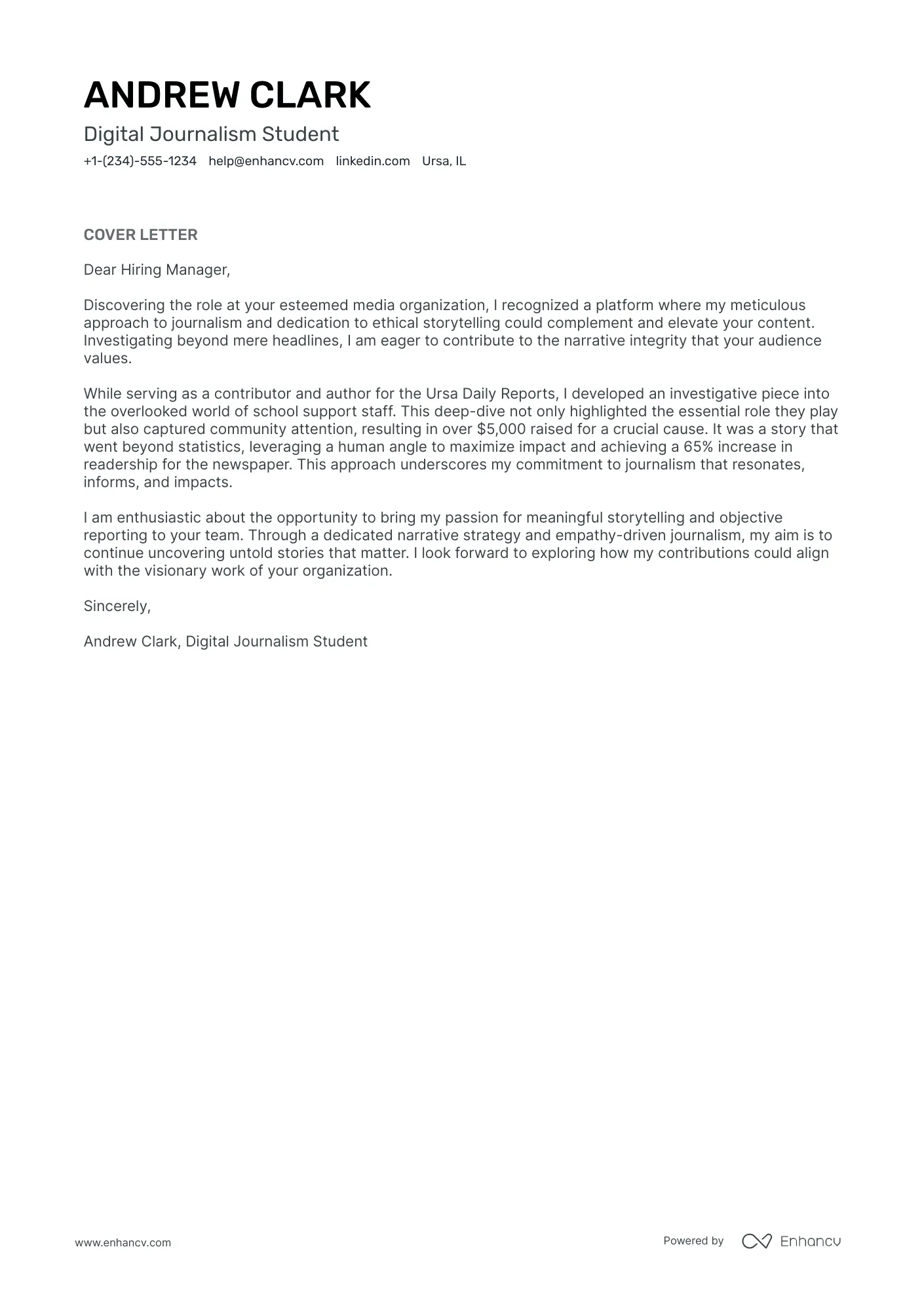
The opening paragraph of your scholarships cover letter is your first chance to captivate the selection committee. Start with a strong statement that clearly states your purpose: to apply for the scholarship and briefly explain why you are a suitable candidate. Make it personal and engaging, mentioning something specific that sparked your interest in the scholarship or the organization. This can be a relevant quote or a brief anecdote that illustrates your commitment to the field of study or the values promoted by the scholarship. This initial paragraph sets the tone for the rest of your letter. It should show enthusiasm and highlight your key qualifications. Keep it concise and focused; avoid generic introductions. The opening paragraph should intrigue the readers and make them want to learn more about you.
Highlight Your Academic Achievements
In the body, showcase your academic achievements, providing evidence of your dedication to learning. Mention your GPA, any honors or awards you have received, and your major or area of study. Highlight relevant coursework or projects that demonstrate your skills and interests. Provide specific examples to illustrate your accomplishments, such as exceptional grades in key subjects, recognition on the Dean’s List, or participation in research projects. These accomplishments should support your application and demonstrate your commitment to academic excellence. Quantify your achievements whenever possible, such as by providing specific grades or the ranking you received. Also, clearly link your academic achievements to your future career aspirations and the goals of the scholarship. Make sure this section is well-organized, with each achievement clearly explained and its relevance emphasized.
Emphasize Your Extracurricular Activities
Your scholarships cover letter should emphasize your extracurricular activities to show your well-roundedness. Mention clubs, sports, volunteer work, and any leadership roles you’ve held. Describe what you did in each activity and the skills you gained. Highlight experiences that reflect your values and leadership qualities. Examples might include leading a club, organizing a community service event, or participating in a sports team. Show how these activities connect to your academic and career goals. These experiences demonstrate your ability to balance academics with other commitments. Show any impact you have made in these activities. Being specific about your responsibilities and the impact you had makes your experiences more compelling. Demonstrate how these extracurriculars have helped you grow as a person and prepared you for future success.
Showcase Your Financial Needs
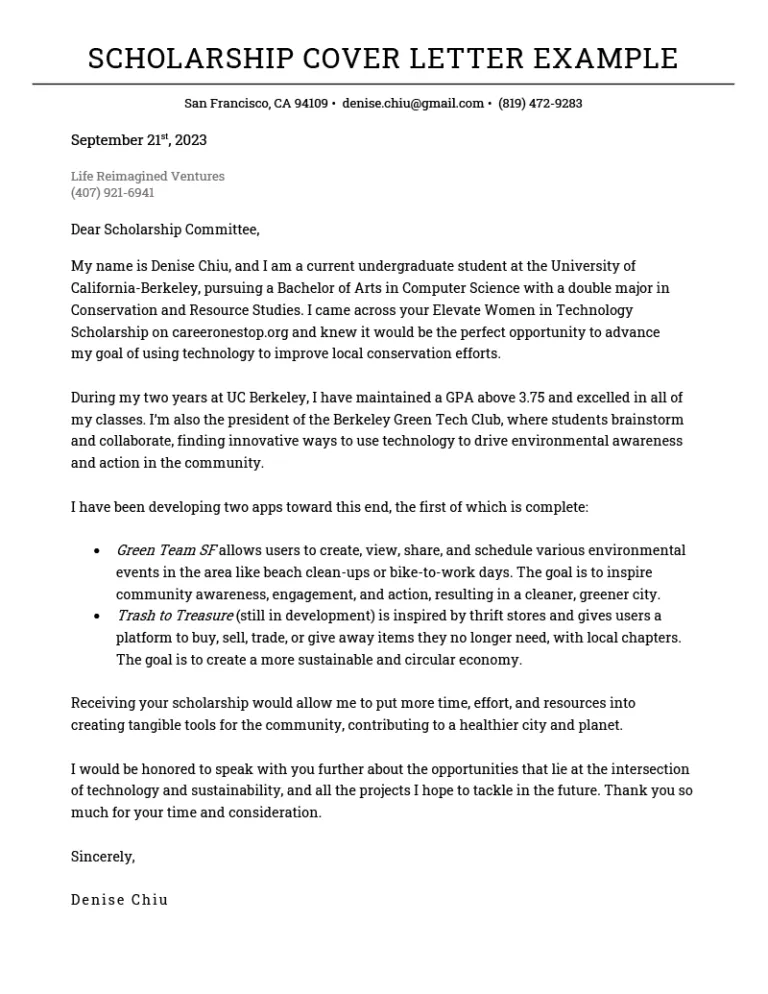
In your scholarships cover letter, you can briefly showcase your financial needs to explain why you are applying. Describe your financial situation and how the scholarship will help you. Explain any challenges you face, like needing to work while studying or not having family support. Be transparent about your financial situation. Explain how this scholarship will alleviate your financial burdens and allow you to focus on your studies. You may briefly mention your family’s financial situation, emphasizing any specific circumstances that make the scholarship essential. Connect your financial needs to your academic and career aspirations, showing how this financial aid will enable you to pursue your goals. Focus on how the scholarship will contribute to your success. Keep the tone professional and respectful. This section demonstrates your need and your resolve.
Demonstrate Your Future Goals
Concluding the body of your scholarships cover letter, clearly demonstrate your future goals and how the scholarship will help you achieve them. Describe your career aspirations and what you plan to do after completing your education. Explain how the scholarship will enable you to reach these goals. Connect your goals to the values and mission of the scholarship provider. Show that you align with their vision. Be specific about your plans and how the scholarship will contribute to your success. Detail what you plan to do with your education and how you will make a difference in your field. Express your passion for your chosen career and your dedication to making a positive impact in the world. This section is crucial, demonstrating that you have a clear vision for your future and that you are committed to achieving your goals.
Closing Your Scholarships Cover Letter
The closing of your scholarships cover letter is your final chance to make a lasting impression. It should reiterate your interest in the scholarship, express your gratitude, and provide a clear call to action. Thank the scholarship committee for considering your application and for their time and attention. Reiterate your enthusiasm for the scholarship and your commitment to using the opportunity to achieve your goals. Be polite and professional, and end with a strong closing. A clear and concise closing reinforces your key points and leaves a positive impression on the reviewers. Expressing genuine gratitude and reiterating your interest ensures that your application ends on a positive and memorable note. Always proofread your closing carefully, ensuring there are no errors in your language or contact information.
Express Gratitude and Reiterate Interest
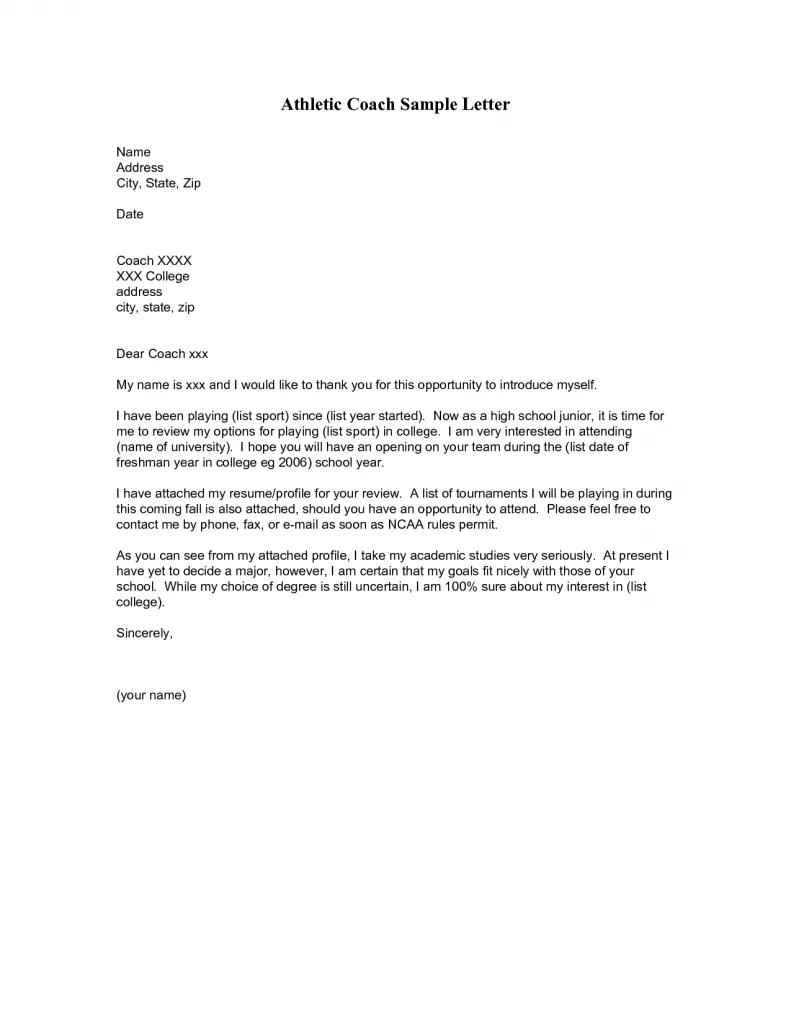
In your closing, express gratitude to the scholarship committee for taking the time to review your application. Specifically, thank them for their consideration. Reiterate your strong interest in the scholarship and your commitment to achieving your goals. Reaffirm why you believe you are a good fit for the scholarship. State your willingness to provide any additional information or documents they might need. Ending with a clear and concise closing reinforces your key points. This shows you value their time. Make sure you use a professional closing such as “Sincerely” or “Respectfully.” Your final sentence should leave a lasting impression. Make sure to keep the tone professional and courteous throughout the closing.
Review and Proofread Your Cover Letter
Reviewing and proofreading your scholarships cover letter is essential before submission. Read your cover letter carefully to ensure that everything is clear, concise, and error-free. Check for any grammatical errors, spelling mistakes, and punctuation issues. Make sure that the formatting is consistent and that the information is presented logically. Proofread multiple times, preferably at different times. This helps you catch any errors that you might have missed. Ask a friend, family member, or career counselor to review your cover letter. Another set of eyes can identify mistakes or suggest improvements. Ensure that the content is relevant, that all the information is accurate, and that you have met all the requirements of the scholarship. A well-proofread cover letter demonstrates your attention to detail, making a positive impression on the selection committee.
Formatting Tips for Your Cover Letter
Proper formatting enhances the readability and professionalism of your scholarships cover letter. This makes your letter easy to read and visually appealing, which is important to the selection committee. Stick to standard font and size, proper margins and spacing. Ensure the text is legible and well-organized. Formatting makes a difference in the reader’s experience. Maintaining a clean, well-formatted cover letter ensures that the message you want to communicate is not missed. Use appropriate spacing and indentation. A well-formatted letter reflects professionalism and attention to detail, increasing your chances of success.
Font and Font Size Guidelines
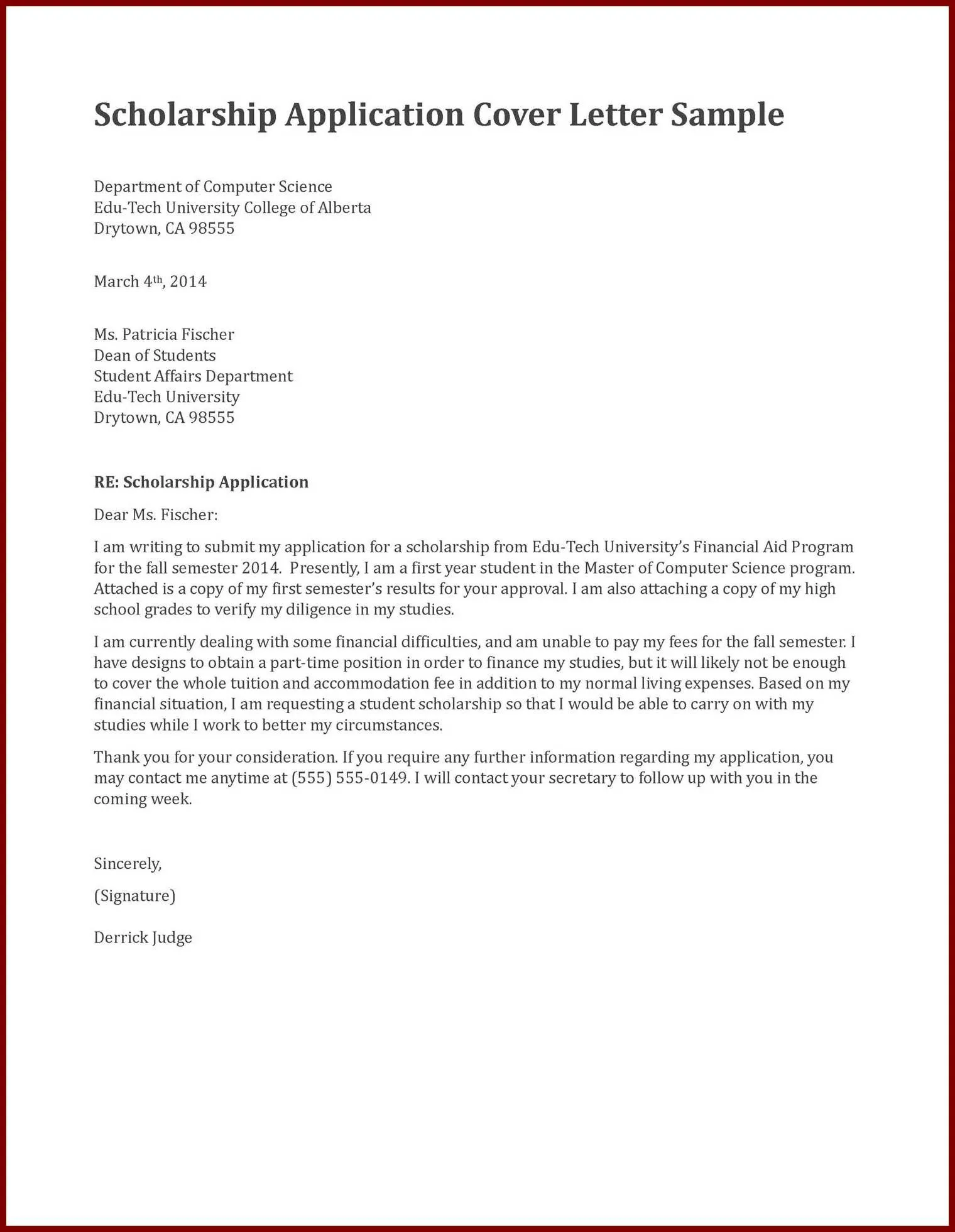
Select a professional and easy-to-read font for your scholarships cover letter, such as Times New Roman, Arial, or Calibri. Stick to a standard font size, usually 11 or 12 points, for readability. Ensure the font size is consistent throughout the letter. The right font choice makes the letter easy to read and presents a professional appearance. Avoid using fancy or overly stylized fonts, as they can be distracting and difficult to read. The right font size is essential for easy reading, so avoid using a font size that is too small or too large. When in doubt, choose a simple, widely used font that is clear and legible. This will help ensure your cover letter is easily read and well-received by the scholarship committee.
Page Margins and Spacing Rules
Use standard page margins, typically 1 inch on all sides of your scholarships cover letter. This provides sufficient space around the text, making it easier to read. Use single or 1.15 line spacing throughout your letter. Make sure the spacing between paragraphs is consistent. Proper margins and spacing contribute to a neat and organized appearance, which is essential for a professional cover letter. Ensure consistent spacing throughout. If you choose to indent paragraphs, be consistent with the indentation style. The right margin, spacing, and indentation contribute to readability and professionalism. Following formatting rules helps your cover letter appear polished and well-organized, increasing its appeal to the selection committee.
File Format for Submission
Always submit your scholarships cover letter in the correct file format as specified by the scholarship provider. The most common and preferred format is PDF (Portable Document Format), because it preserves your formatting, ensuring that your letter appears as intended. Make sure to name your file appropriately, including your name and the name of the scholarship. Avoid using formats that may be unstable or require special software to open, such as DOC or DOCX files, unless specifically requested. Always double-check the file format instructions before submitting your application. Preparing the file correctly demonstrates attention to detail and a commitment to following instructions. Submitting your cover letter in the right format ensures that your application is viewed correctly and presents you professionally.
